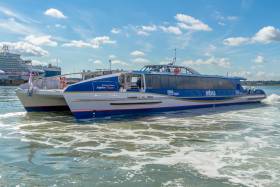Displaying items by tag: LISW17
New London Commuter Catamarans Enter Thames Service
#ferry - Afloat last week featured Dublin Discovered Boat Tours, the capital's only dedicated operator on the Liffey, among it's London counterparts are MBNA Thames Clippers which introduced brand new craft but also commissioned to transport commuters, writes Jehan Ashmore.
The newbuild Jupiter Clippper with capacity for 172 passengers is the youngest member of MBNA Thames Clippers having entered service last month following debut of sister Mercury Clipper. They join a fleet providing rapid transport services through central London on various routes based between Putney in the west to Royal Woolwich Arsenal in the east.
Both craft represent (as Afloat reported last year) the largest fast commercial passenger ferries contracted from a UK shipyard in over 25 years and to serve in the nation's coastal waters. The pair made the 200 nautical mile delivery passage from Wight Shipyard Co Ltd on the Isle of Wight to the Trinity Buoy Wharf in east London.
Combined the passenger catamarans form a £6.3 million investment in London’s port and transport infrastructure to provide an additional 14% capacity and increased frequency cross the River Thames network. They are the most technically advanced and energy efficient fast ferries so far for MBNA Thames Clippers that now totals a fleet of 17 craft. The operator expects by the end of 2017 to have carried over four million commuters and tourists alike on Old Father Thames.
The build process took 10 months to complete Jupiter Clipper and Mercury Clipper and this led to the creation of over 75 new jobs across the Isle of Wight and London in the process. The 35m long catamarans are of the Hunt Class Mark 2, designed by Australian naval architects One2Three based in Sydney. They are built to ultra-high specifications among them incorperating a low-wash hull design likewsise of near sisters Clipper Neptune and Galaxy Clipper of the Hunt Class. These slightly smaller 150 passenger capacity craft having only entered service in 2015, make up the most modern and largest fleet on the Thames.
Also as part of river developments before the end of this year will be the completion of three piers added to the MBNA Thames Clipper commuter network. The locations are Plantation Wharf Pier, Westminster Pier and Battersea Power Station Pier.
MBNA Thames Clippers are committed to making the river as accessible to as many people as possible. Also their support of the Port of London Authority (PLA) Thames Vision of doubling the number of people travelling by river and its target of 20 million commuter and tourist trips every year.
As part of the last week's London International Shipping Week attended by the IMDO, a private charter of Thames Clipper was planned by LISW17 for delegates to take a special excursion of the PLA terminals. Among them in London's east docklands is located in Erith (Conway's berth for aggregates) and where during LISW17 Afloat had tracked down cargoship Arklow Resolve (see rare Dublin Cargoship Call to 'Docklands')
It was at this same berth in Erith, that Afloat had also followed Arklow Resolve make a previous call in late August, having finally departed Dublin Port notably where the 2,999grt cargoship had made a rare layover period of more than a month. This took place in the capital's old inner port that is referred as the 'Docklands' quarter, the Irish equivalent of London's Canary Wharf occupied by the financial services sector.























